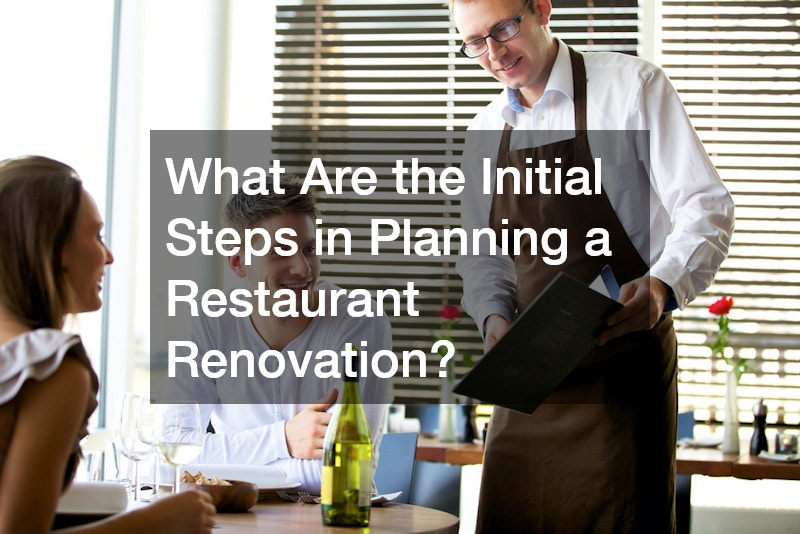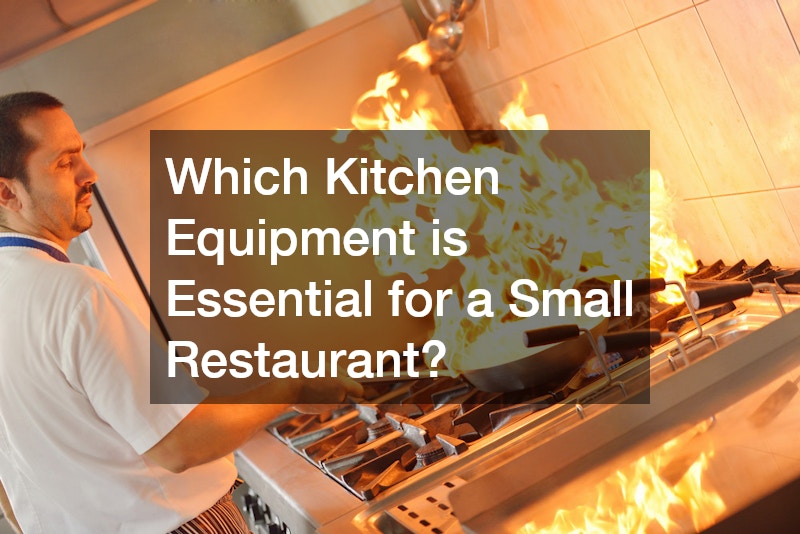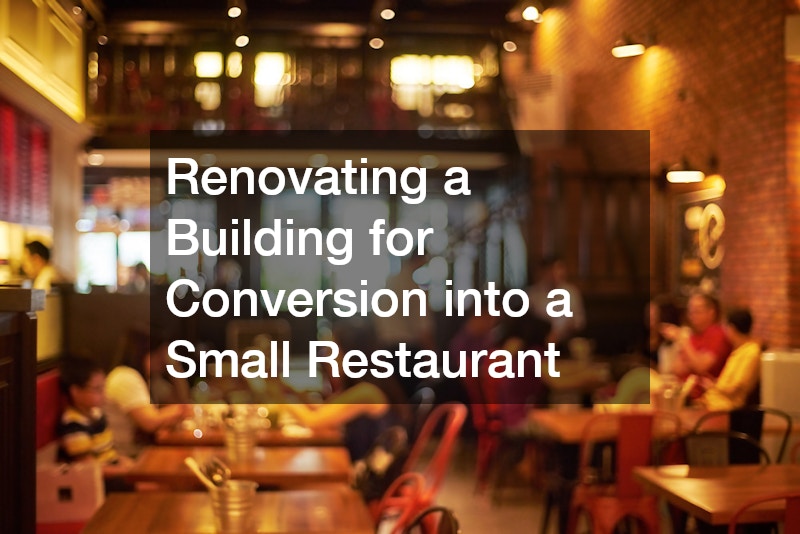Renovating a Building for Conversion into a Small Restaurant
The trend of converting existing buildings into small restaurants has grown significantly in recent years. Entrepreneurs and restaurateurs are increasingly recognizing the value of repurposing spaces rather than starting from scratch. Existing structures offer unique architectural features, cost savings, and a chance to create a distinctive dining experience. However, renovating a building for restaurant use comes with its own challenges, including structural limitations, regulatory compliance, and operational considerations. Successfully navigating these challenges requires thorough planning, a clear vision, and an understanding of the specialized services needed during the renovation process. From commercial construction to food logistics, every aspect must be carefully managed to transform a building into a thriving restaurant.
What Are the Initial Steps in Planning a Restaurant Renovation?

Planning is the foundation of any successful restaurant renovation. Early steps determine whether the project is feasible, sustainable, and profitable.
Conducting a Feasibility Study
A feasibility study is essential to evaluate whether a building is suitable for restaurant conversion. This includes analyzing location, accessibility, parking availability, competition, and customer demographics. Understanding the surrounding neighborhood and potential market ensures that the restaurant can attract enough business to sustain operations. Additionally, feasibility studies often include assessments of commercial cleaning service availability, which is crucial for ongoing hygiene standards once the restaurant is operational.
Defining the Restaurant Concept
Your restaurant concept shapes every element of the renovation, from the layout to the menu. Whether planning a casual eatery, fine dining establishment, or specialized business catering operation, the concept must be clear. This clarity guides decisions about seating arrangements, kitchen layout, décor, and workflow. For restaurants offering business catering services, for example, kitchen design must accommodate packaging, storage, and delivery logistics.
Establishing a Budget
Renovation budgets must account for a wide range of costs, including commercial construction, equipment, permits, and interior design. Projects often encounter unforeseen expenses, such as hidden structural damage or the need for additional demolition service work. Allocating a contingency fund is essential to manage these unexpected costs. Balancing budget constraints with the need for durable materials and quality equipment ensures the restaurant is both functional and financially sustainable.
Obtaining Necessary Permits and Licenses
Restaurants are subject to strict regulations regarding food safety, fire codes, accessibility, and business operation. Obtaining the proper permits early is critical to avoid delays. This includes approvals for commercial cooking oils storage, garbage collection management, and waste disposal processes. Regulatory compliance protects the restaurant from legal issues and creates a safe environment for staff and patrons.
Hiring a Professional Team
A professional team ensures the project is executed efficiently and meets high standards. Architects, designers, contractors, and engineers specializing in commercial construction bring expertise in structural modifications, layout optimization, and compliance. Involving experts in metal fabrication or commercial fence installation can enhance functionality and security, particularly if the property includes outdoor dining or storage areas.
How Do You Assess the Building’s Structural Integrity?
Before remodeling, understanding the existing structure is critical. Structural issues affect both safety and design possibilities.
Inspecting Foundation and Building Materials
A stable foundation and strong building materials are essential to support restaurant operations. Inspecting the foundation for cracks, settling, or water damage is critical. Similarly, evaluating walls, ceilings, and floors ensures they can withstand the weight of commercial kitchen equipment and high customer traffic. Incorporating durable materials can reduce long-term maintenance costs.
Evaluating Load-Bearing Walls
Load-bearing walls provide critical structural support, so removing or altering them requires careful planning. For restaurants with open layouts or large dining areas, structural engineers can recommend alternatives, such as reinforced beams, to maintain safety while creating flexible spaces.
Checking for Water Damage and Mold
Water damage and mold pose significant health risks and can compromise the building’s integrity. A thorough inspection ensures that any leaks, rot, or dampness are addressed before renovation. This step is particularly important for kitchens and storage areas where commercial cooking oils and food waste handling could exacerbate moisture-related problems.
Reviewing Building Code Requirements
Restaurants must comply with local building codes covering fire safety, sanitation, electrical systems, and accessibility. Understanding these codes early in the renovation process ensures the design meets regulatory requirements. Failure to comply can result in fines, delays, or costly rework.
Consulting with Structural Engineers
Structural engineers provide expertise on the building’s capabilities and limitations. Their guidance ensures the structure can safely support kitchen equipment, dining areas, and storage needs, including metal fabrication elements or commercial fence installations for outdoor spaces. Consulting engineers reduces the risk of costly structural errors and ensures a safe environment for patrons and staff.
What Are the Key Considerations for Designing a Restaurant Layout?

A well-planned layout balances functionality, safety, and customer experience. The design must optimize workflow, accommodate guests comfortably, and ensure staff efficiency.
Flow of Traffic and Kitchen Efficiency
Efficient traffic flow is crucial to prevent congestion in both the dining area and kitchen. The layout should allow servers to move smoothly between tables while giving kitchen staff direct access to prep and cooking stations. Restaurants that handle food logistics for delivery or catering need additional space for packaging and staging orders. Properly designed flow reduces errors and improves overall efficiency.
Seating Capacity and Arrangements
Seating arrangements influence revenue, comfort, and ambiance. Designers must balance maximum capacity with comfort and safety, ensuring patrons have enough personal space while maintaining operational efficiency. Flexible arrangements can accommodate both dine-in guests and business catering pickups.
Compliance with Accessibility Standards
Accessibility is not optional; it’s a legal requirement. Restaurants must provide wheelchair-accessible entrances, seating, restrooms, and pathways. Compliance ensures that every guest can enjoy the space safely, reflecting an inclusive and welcoming business approach.
Integrating Aesthetic and Functional Design
The interior should reflect the restaurant’s concept while remaining practical. Materials must withstand high traffic, spills, and cleaning processes. Commercial cleaning service considerations should influence material selection to simplify maintenance while preserving the intended aesthetic.
Incorporating Safety Features
Safety is a priority in restaurant design. Fire extinguishers, clear exits, anti-slip flooring, and proper ventilation are all essential. These features protect both staff and customers, particularly in areas where commercial cooking oils and other flammable materials are used.
How Do You Choose the Right Materials for Renovation?
Selecting the right materials balances durability, aesthetics, cost, and regulatory compliance.
Prioritizing Durability and Maintenance
Restaurant spaces endure heavy use. Flooring, countertops, and wall finishes must withstand constant wear. Durable materials also support frequent cleaning, particularly important when working with commercial cooking oils and food waste to prevent stains and odors.
Selecting Energy-Efficient Options
Energy efficiency reduces operational costs and supports sustainability goals. Choosing energy-efficient lighting, HVAC systems, and kitchen appliances benefits both the environment and the bottom line. Energy-efficient materials for insulation and roofing also contribute to maintaining consistent indoor temperatures.
Sourcing Eco-Friendly Materials
Sustainable material choices support environmental responsibility. Using recycled or responsibly sourced materials reduces the restaurant’s environmental footprint and aligns with growing customer preferences for eco-conscious businesses.
Balancing Cost and Quality
Cost considerations cannot compromise quality. Selecting materials that are both durable and visually appealing ensures long-term satisfaction while avoiding excessive maintenance costs. This balance also allows for strategic investments in areas that impact customer experience most, such as seating, countertops, or flooring.
Assessing Local Availability of Materials
Using locally available materials can reduce shipping costs and support local businesses. Items such as metal fabrication components, commercial fence materials, and certain construction supplies are often easier to source locally, streamlining project timelines and reducing logistical complications.
Which Kitchen Equipment is Essential for a Small Restaurant?

The kitchen is the heart of any restaurant. Choosing the right equipment ensures efficiency, consistency, and safety.
Choosing the Right Cooking Appliances
Commercial-grade cooking appliances are essential for consistent food quality. Equipment must be appropriate for the menu while accommodating energy efficiency. Consideration of commercial cooking oils storage and handling is important to maintain safety and minimize waste.
Selecting Refrigeration and Storage Solutions
Proper refrigeration and storage are crucial for food safety. Efficient, well-organized refrigeration allows for smooth food logistics, reducing spoilage and ensuring freshness. Storage solutions should accommodate both daily inventory and special items used for business catering.
Opting for Efficient Food Preparation Tools
Food preparation tools, such as mixers, slicers, and processors, streamline kitchen operations. Selecting tools suited to the menu enhances productivity and reduces staff fatigue. Tools designed for easy cleaning also support commercial cleaning service practices.
Considering Space-Saving Equipment
Small restaurants often face space constraints. Compact, multi-functional equipment ensures the kitchen remains functional without overcrowding. This includes stackable refrigeration units or modular cooking stations that maximize utility.
Aligning Equipment with Menu Needs
Equipment selection should align with the restaurant’s menu and service style. A business catering operation, for instance, may require additional prep space, warming stations, or specialized ovens to accommodate large orders efficiently.
How Do You Ensure Proper Ventilation and Air Quality?
Ventilation and air quality are vital for safety, comfort, and compliance.
Designing an Effective Exhaust System
A properly designed exhaust system removes smoke, steam, and odors from cooking areas. This is particularly important when handling commercial cooking oils, which can produce fumes and grease buildup if not properly ventilated.
Choosing Energy-Efficient HVAC Solutions
HVAC systems regulate temperature and air quality efficiently. Energy-efficient units reduce operational costs while maintaining a comfortable dining environment for guests and a safe workspace for kitchen staff.
Aligning with Health and Safety Regulations
Ventilation must meet local health and safety codes, including air circulation, grease management, and humidity control. Compliance ensures safe handling of food waste and reduces risk of contamination.
Controlling Humidity Levels
Proper humidity control prevents mold, maintains food quality, and enhances comfort. Managing humidity also protects structural elements, such as metal fabrication components and flooring materials, from moisture damage.
Regular Maintenance and Cleaning
Routine maintenance of ventilation and HVAC systems prevents buildup of grease, dust, and contaminants. Engaging a commercial cleaning service helps maintain air quality and keeps equipment operating efficiently.
What Are the Best Practices for Effective Lighting Design?
Lighting sets the mood, enhances functionality, and improves safety.
Balancing Natural and Artificial Light
Natural light creates a welcoming atmosphere and reduces energy consumption, while artificial lighting ensures visibility after dark. Strategically placed windows and light fixtures can enhance both ambiance and operational efficiency.
Enhancing Ambiance through Lighting
Lighting can reinforce the restaurant’s theme, highlight décor elements, and create inviting dining spaces. Adjustable lighting allows flexibility for different times of day and event types, including business catering functions.
Prioritizing Energy-Efficient Solutions
Energy-efficient LED fixtures reduce electricity costs and support sustainability initiatives. They also generate less heat, which benefits kitchen comfort and reduces strain on HVAC systems.
Complying with Safety and Accessibility Standards
Lighting must illuminate pathways, exits, and work areas adequately. Proper placement ensures compliance with accessibility standards, preventing accidents for both staff and patrons.
Planning for Easy Maintenance
Fixtures should be easy to clean and maintain, especially in kitchens where grease and dust accumulation is common. This also simplifies the work of commercial cleaning services.
How Can You Design a Memorable Exterior and Interior Décor?
A restaurant’s design influences customer perception and loyalty. Thoughtful décor enhances both visual appeal and operational functionality.
Reflecting the Theme in Design
The exterior and interior should convey the restaurant’s identity. This includes color schemes, textures, and furniture styles that resonate with the concept. Outdoor spaces may feature commercial fences for privacy and security while enhancing aesthetics.
Using Color Schemes Effectively
Color impacts mood and appetite. Harmonious color schemes create a welcoming atmosphere that complements the restaurant’s theme. Colors can also be used to define functional areas, such as dining, bar, or catering prep spaces.
Selecting Furniture and Fixtures
Furniture should balance comfort, style, and durability. Fixtures such as lighting, shelving, and display units must be both functional and aesthetically pleasing. Materials resistant to spills and wear help maintain a polished appearance over time.
Displaying Art and Decorative Elements
Art and décor contribute to the dining experience, reinforcing the restaurant’s brand. Strategic placement of art and decorative elements can create focal points and enhance ambiance without interfering with traffic flow or operations.
Enhancing Curb Appeal
The exterior sets the first impression. Attractive signage, lighting, and landscaping encourage foot traffic and complement the overall restaurant concept. Commercial fencing and outdoor seating areas can create a welcoming entry while providing security and privacy.
What Role Does Technology Play in Renovation?
Technology enhances efficiency, customer satisfaction, and operational control in modern restaurants.
Integrating Smart Kitchen Devices
Smart devices streamline cooking, monitoring, and maintenance tasks. Temperature-controlled storage, programmable ovens, and automated timers improve consistency and reduce human error.
Implementing an Effective Ordering System
Digital ordering platforms support dine-in, delivery, and business catering services. These systems improve order accuracy, track inventory, and enhance customer convenience.
Utilizing Technology for Efficient Operations
Software for scheduling, inventory management, and waste tracking helps streamline operations. Proper food waste management reduces environmental impact and lowers operational costs while maintaining compliance with regulations.
Enhancing Customer Experience with Tech
Customer-facing technology, such as mobile ordering apps, digital menus, and loyalty programs, creates a modern, convenient dining experience. Technology also supports food logistics for timely delivery of catering and online orders.
Ensuring Cybersecurity and Privacy
With increased reliance on technology comes the need for data protection. Secure payment systems and privacy-conscious customer databases safeguard sensitive information, ensuring trust and compliance with privacy laws.
How Do You Plan for a Successful Opening?

A strategic launch sets the tone for long-term success, building customer awareness and loyalty.
Scheduling a Soft Opening
Soft openings allow staff to practice operations in real conditions, identify workflow issues, and gather feedback. This is essential for restaurants that manage high-volume business catering and daily food logistics.
Crafting a Marketing and Promotion Plan
Marketing strategies create buzz and attract customers. Social media campaigns, local advertising, and community events help introduce the restaurant, generate reservations, and promote catering services.
Training Staff for Opening Day
Proper staff training ensures efficiency, safety, and exceptional service. Training should cover equipment use, food handling, commercial cleaning protocols, and procedures for handling commercial cooking oils and food waste safely.
Collecting Feedback for Improvements
Feedback from patrons during the initial weeks provides insights for operational adjustments, menu refinement, and service improvements. Engaging with customer opinions demonstrates a commitment to quality and adaptability.
Planning for Long-term Growth and Sustainability
Sustainable growth involves optimizing operations, maintaining hygiene standards, and continuing staff development. Partnerships with a reliable garbage collection company support consistent waste management, while ongoing investments in commercial construction improvements keep the building in peak condition.
Final Thoughts
Converting an existing building into a small restaurant is a multifaceted process that requires careful planning, strategic design, and expert execution. From assessing structural integrity and selecting materials to integrating technology, managing food logistics, and maintaining hygiene through commercial cleaning service practices, every detail contributes to success. When executed thoughtfully, renovations transform underutilized spaces into vibrant restaurants capable of delivering exceptional dining experiences and thriving business operations. By incorporating key considerations like commercial construction expertise, demolition service, metal fabrication, commercial fence installation, and proper handling of commercial cooking oils and food waste, restaurateurs can ensure their new venture is both functional and appealing, creating a solid foundation for long-term growth.
